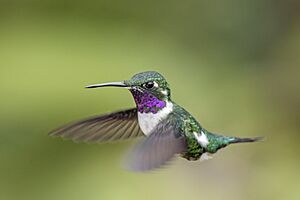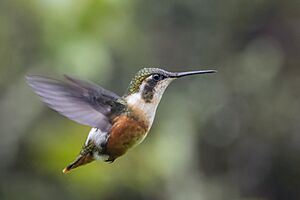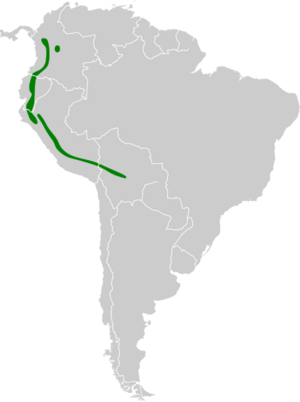White-bellied woodstar facts for kids
Quick facts for kids White-bellied woodstar |
|
|---|---|
 |
|
| Male, Chocó, Colombia | |
 |
|
| Female, Cundinamarca, Colombia | |
| Conservation status | |
| Scientific classification | |
| Genus: |
Chaetocercus
|
| Species: |
mulsant
|
 |
|
| Synonyms | |
|
Acestrura mulsant |
|
The white-bellied woodstar (Chaetocercus mulsant) is a tiny, colorful hummingbird. It belongs to a group of hummingbirds called "bee hummingbirds." You can find this bird in several South American countries. These include Bolivia, Colombia, Ecuador, and Peru.
Contents
About the White-bellied Woodstar
The white-bellied woodstar is a small bird. It measures about 8.5 centimeters (3.3 inches) long. It weighs only about 3.8 to 4 grams (0.13 to 0.14 ounces). Both male and female birds have a straight, black beak.
What Male Woodstars Look Like
Male white-bellied woodstars are very striking. Their upper body is a dark bluish-green color. This color also extends down their sides. They have a bright, shiny reddish-violet throat patch, called a gorget. A white line curves behind their eye. This line connects to a white area on their upper chest. Their belly is white, and they have white patches on their sides. The male's tail is forked and bluish-green. The outer tail feathers are mostly just shafts, without much feather material.
What Female Woodstars Look Like
Female white-bellied woodstars look a bit different. Their upper body is a bronzy-green color. They have a grayish "mask" on their face. A buff-colored stripe runs behind their eye. Their throat is a pale cinnamon color. The belly is white, and their sides are a tawny (light brownish-orange) color. The female's tail is rounded. The middle tail feathers are green. The other tail feathers are cinnamon with a wide black band near the end.
Where White-bellied Woodstars Live
The white-bellied woodstar lives in the Andes Mountains. You can find them in the central and eastern parts of Colombia. From there, they live south through Ecuador and Peru. Their range extends into Bolivia, as far as the Cochabamba Department.
Woodstar Habitats
These birds like to live on the edges of humid forests. They also live in pastures and areas where people grow crops. They are most common at elevations between 2,200 and 2,800 meters (7,200 to 9,200 feet). However, they can sometimes be found as low as 1,500 meters (4,900 feet). There are even reports of them living as high as 4,000 meters (13,000 feet).
Woodstar Behavior
Woodstar Movements
The white-bellied woodstar usually stays in one area. However, the sightings at very high elevations suggest something interesting. It might move to different altitudes depending on the season.
How Woodstars Find Food
White-bellied woodstars look for food at all levels of plants and trees. They drink nectar from many different flowering plants. These include plants like Agave, Inga, and Lantana. They also eat small arthropods, which are tiny insects and spiders. These hummingbirds do not protect their feeding spots. Because they are so small and fly slowly, like a bumblebee, they can often feed in areas where other hummingbirds might chase them away.
Woodstar Reproduction and Life Cycle
Scientists do not know much about how white-bellied woodstars reproduce. Only one nest has ever been found. It was discovered in Ecuador in April. The nest was about 10 meters (33 feet) high in a tree.
Woodstar Sounds
The white-bellied woodstar makes a few different sounds. Their calls include a low "djup" note. They also make a higher, dull "chip" sound.
Woodstar Conservation Status
The IUCN (International Union for Conservation of Nature) has checked on the white-bellied woodstar. They have listed it as a species of "Least Concern." This means it is not currently in danger of disappearing. The bird lives across a large area. Even though we don't know the exact number of birds, their population seems to be stable.
Some people think these birds are uncommon. Others say they are common in certain places. It's possible there are more of them than we realize. They are small and easy to miss. The good news is that they seem to be able to live well in areas changed by humans.


